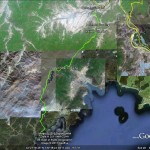Pictured above (Google Earth) is the electrified fence around the Rason special economic zone.
Lankov writes in the East Asia Forum:
SEZs are acceptable to the North Korean government because they are relatively easy to control. North Korean SEZs have been fenced off with barbed wire and all visitors have had their IDs carefully studied at checkpoints.
The North Korean government obviously hopes that small areas of controlled capitalism will generate enough income to make a difference — or at least to keep afloat the long-decaying economy.
Similar SEZs with China to those recently declared have been attempted before. At Raseon a major problem was its isolated location and underdeveloped transport infrastructure, even by meagre North Korean standards. At Sinuiju there were numerous problems. One was North Korea’s choice of the Chinese entrepreneur Yang Bin to lead the project as he wanted to transform the city into a gambling centre, a Macau of the North. This was not welcomed by the Chinese government. Also, it did not help that the North Koreans, following their modus operandi, did not bother to liaise with the Chinese beforehand.
…
The success of KIZ might seem encouraging, but it is actually a very special case. It is viable because the South Korean government is willing to go to great lengths to support it. It has subsidised industrial development and has provided adventurous developers and companies with generous subsidies and guarantees that made the entire undertaking possible. This willingness is driven by a multitude of political considerations. Frankly, it is doubtful whether the Chinese side would be equally interested in subsidising a similar undertaking by Chinese companies in Sinuiju.
…
What will happen to these two planned new SEZs? The fate of Raseon seems pretty certain. Available evidence indicates it is largely about transportation links. Chinese Manchuria is landlocked, so Chinese companies will save a small fortune on transportation costs if they are given access to a seaport on the Eastern coast of the Korean Peninsula. If this is what happens in Raseon, it has a relatively bright future.
The future of the Hwanggumpyong SEZ is far less certain. Obviously Chinese businesses want to do there what their South Korean counterparts did in Kaesong, take advantage of low labour costs in North Korea. Even though Chinese labour is cheap, North Korean labour is much cheaper still, since US$15-20 a month would be seen by the average North Korean worker as a good wage. For the same labour, they would have to pay a Chinese worker between US$100 and US$150 a month.
But that said, the business reputation of North Korean managers leaves much to be desired. They are likely to intervene in operations − partially as a way to extort bribes, but largely because they will worry about excessive exposure of their population to dangerous Chinese influences. South Korean businesses in Kaesong accept such interference, but they are backed by the South Korean government. It remains to be seen whether the same situation will develop in a Chinese-led zone.
Previous posts on the Sinuiju (including Waudo and Hwangumphyong) can be fond here.
Previous posts on Rason (Rajin-Sonbong) can be found here.
Read the full story here:
North Korea-China special economic zones
East Asia Forum
Andrei Lankov
2011-7-14

